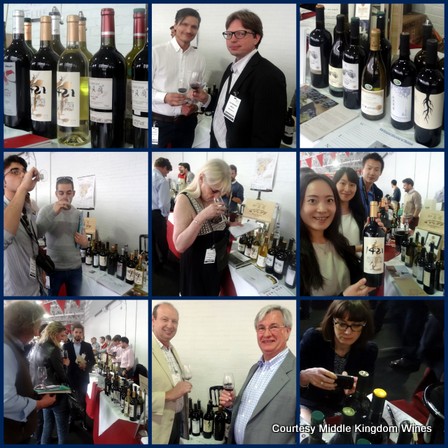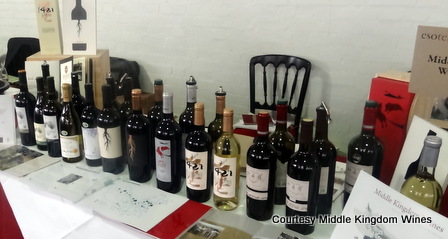
So, what happens if you take a dozen-plus Chinese wines to the London International Wine Fair? That’s one experiment now complete thanks to Kevin Gayle of Middle Kingdom Wines, who presented bottles from four regions of China at his booth this year.
Before we get to the response of visitors — Gayle says they included “wine course students, sommeliers, wine merchants, journalists, wine consultants, wine school lecturers and [members of] wine societies” — here was the portfolio on offer:
1421 (Xinjiang)
- ‘Gold’ Chardonnay 2010
- ‘Gold’ Cabernet Sauvignon 2010
Great River Hill (Shandong)
- Chateau Nine Peaks’ Chardonnay Reserva 2013
- ‘Chateau Nine Peaks’ Cabernet Sauvignon 2011
- ‘Chateau Nine Peaks’ Cabernet Sauvignon Reserva 2011
Helan Qing Xue (Ningxia)
- ‘Jia Bei Lan’Â Cabernet Blend Grand Reserve 2009
- ‘Jia Bei Lan’ Cabernet Blend Reserve 2011
- ‘Jia Bei Lan’ Cabernet Blend Estate 2011
Jin Sha (Inner Mongolia)
- ‘Kinschab Five Stars’ Dry Red 2008
Reifeng-Auzias (Shandong)
- Chardonnay Reserve 2011
- Syrah Reserve 2010
- Cabernet Franc Reserve 2010
Xi Xia King (Ningxia)
- ‘Global Jade Spring’ Chardonnay 2009
- ‘Diplomatic Envoy’ Cabernet Sauvignon 2010
Gayle says that in addition to positive comments about the wine labels — “Everyone thought they were simply fantastic” — he said many people were impressed by the wines themselves.
When it came to the whites, all of them were Chardonnay.
“In terms of popularity, Chateau Nine Peaks and 1421 seemed to be the overall favourites, with Reifeng Auzias and Xi Xia King close behind in third place,” he says. “But all of these wines were picked as ‘the best’ by various visitors over the three-day event.”
He says many visitors found that the wines, particularly from Chateau Nine Peaks and Reifeng-Auzias, “didn’t taste exactly like a Chardonnay” and “quite a few people specified they wouldn’t have guessed the grape accurately in a blind tasting.”
Even so, he found visitors generally preferred the whites to the reds.
“One consultant commented that if he was to recommend one it would be a white simply because white wine drinkers have ‘less sophisticated palates’ and whites in general are less complicated,” he says.
In terms of the reds, he said 1421 Cabernet Sauvignon was “one of the clear favourites”, with the Chateau Nine Peaks Cabernet Sauvignon either tied or close behind and edging out its sibling, the Cabernet Sauvignon Reserve.
“I think in general, with the 1421, people ‘recognized’, and were comfortable with, the taste being ‘exactly what it says on the tin’,” says Gayle. In terms of the pricier reds, he says the Xi Xia King was “very well-liked“.
“One consultant who had enthused about it on day one, returned on the last day to show this wine to a buyer from the Hilton Hotel,” he says.
“With the exception of Jia Bei Lan, all of the other reds were equally well liked, with perhaps the Reifeng-Auzias Syrah and Cabernet Franc pleasantly surprising people as the only non-Cabernet Sauvignons,” he says. “People found the Jia Bei Lan wines interesting. Not as many as I had expected had heard of the 2009 [which won an ‘international trophy’ from Decanter], but in general they recognized these immediately as high-quality wines. Most, like me, found the Jia Bei Lan Reserve 2011 more to their taste than the 2009.”
Not surprisingly, many visitors noted the prices of the Chinese wines. [Reifeng-Auzias, for example, tends to retail for more than rmb1500 / 190 Euro.]
“When all’s said and done, many were surprised at the high prices of some of the wines and naturally compared them to the world-wide competition,” he said. “There were many comments along the lines of ‘Well, who is going to buy that for that when you can get this for this?'”
The ultimate result?
“1421 and Chateau Nine Peaks reds and whites were seen as reasonable entry-level wines, while Xi Xia King ‘Diplomatic Envoy” and Helan Qing Xue ‘Jia Bei Lan’ Estate 2011 were higher-end wines where the price was not too exorbitant,” he says.
“The other wines were more than acceptable but their prices needed to take into account the huge supply of wine. In general, it was a worthwhile experience. Lots of people looking for something ‘different’ found it on my table – and were pleasantly surprised at the quality. Whether this turns into sales is another story.”
Grape Wall has no sponsors of advertisers: if you find the content and projects like World Marselan Day worthwhile, please help cover the costs via PayPal, WeChat or Alipay.
Sign up for the free Grape Wall newsletter here. Follow Grape Wall on LinkedIn, Instagram, Facebook and Twitter. And contact Grape Wall via grapewallofchina (at) gmail.com.


Leave a Reply
You must be logged in to post a comment.